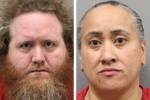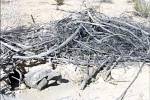Health officials see drop in H1N1 flu cases since October
Could the H1N1 flu season be in the rearview mirror?
That's the question health officials are asking as data indicate the number of H1N1 cases nationwide, as well as in Clark County, continues to dwindle.
The numbers in Clark County show that serious cases have dropped considerably since October. The Southern Nevada Health District counts a serious case as one in which a patient is hospitalized or when lab results are sent by a physician to the health district.
For the week ending Oct. 24, 854 such cases of H1N1 were confirmed. For the week ending Dec. 12, only 109 such cases were confirmed.
The Dec. 12 total was 47 cases higher than the Nov. 28 season low of 62. Still, the figures are heading down. Local health officials began administering the vaccine Oct. 10 and have expanded the pool of eligible recipients since.
Health district spokeswoman Jennifer Sizemore said the drop in cases is probably a combination of more residents receiving vaccinations, as well as increased immunity in the population because of people who have already contracted and overcome the virus.
"It's not surprising we're seeing this drop," Sizemore said.
The typical flu season peaks in January in Clark County, she said, but the season started earlier in 2009. "Everything is very unpredictable, but we think we've seen the worst of it," she said.
Dr. John Middaugh, the district's director of community health, said the rate of disease has declined across the country for the past three or four weeks, including a large decrease in hospitalizations.
"I can't tell you how pleased we are that's the case," he said.
Middaugh said that although statistics are positive, the question remains: Will the number of cases continue to drop?
"Predicting the flu is like predicting the stock market," he said.
If Nevadans are lucky, he said, this wave of H1N1 cases represents an early flu season that's coming to an end.
But because flu season in Nevada typically lasts six to eight weeks and occurs in February or March, Middaugh said it is possible that H1N1 could come back.
And if H1N1 doesn't come back, it's still possible that a different strain of flu will rise as the H1N1 falls.
"We're trying to figure out if we escaped the outbreak of H1N1, and it's over, or if it's a lull followed by another wave," he said.
Because of the uncertainty, Middaugh said the health district is pushing for all Nevadans to receive an H1N1 vaccination.
Even if the virus doesn't emerge again this year, officials believe the strain will be the dominant one for several years.
Because the county has a high number of vaccines available, there's no reason to avoid a shot, he said.
"Then they'll be protected through the spring and into the next flu season, in fall 2010," he said.
And even though the virus appears to be less widespread, people in Clark County are still dying from complications.
Two more deaths related to the H1N1 flu have been confirmed in Clark County, the health district reported Wednesday. Those deaths involved a 20-year-old man and a 56-year-old man, both with underlying medical conditions.
H1N1 has now been a factor in the deaths of 32 residents in Clark County, district officials say.
Middaugh said there's no real way to predict who will get the flu each season. And the reality is, he said, some people will die from flu each year.
"That's what the flu does," he said. "Even with superb care, some people do not recover from influenza."
Contact reporter Mike Blasky at mblasky@reviewjournal.com or 702-383-0283.




























